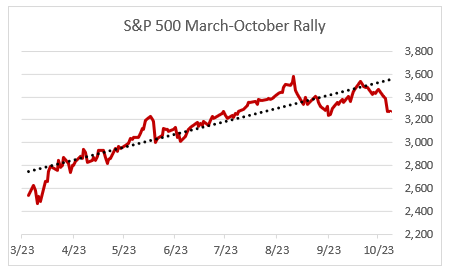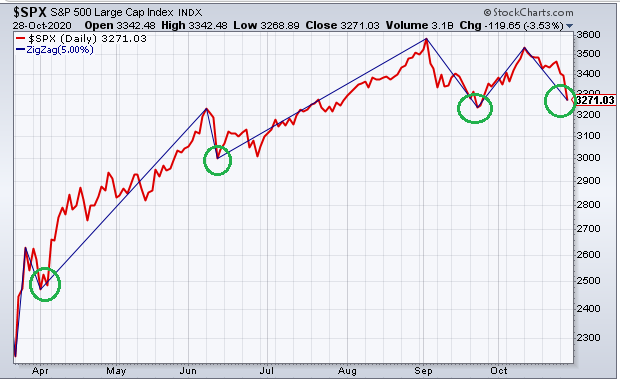Has the valuation bubble finally burst?
Today was the 69th worst day for the market since 1950. We have now erased a full month of market gains in just three days. After the September rout (down 6.1% on the S&P 500), October was looking like it would recover and possibly make a new all-time market high. Alas, it was not to be.
After rallying to within 1.3% of the all-time market high on October 12, the market has given back all of those gains. What's going on?
The October give-back is all about Covid
The recent surge in cases and deaths are the real story, but this article focuses on how the surge might impact the economy and the market. According to the stories I've seen today, Europe and the U.S. might be headed in the direction of more restrictions, mask mandates, and lockdowns.
That does not bode well for the nascent economic recovery we saw this summer. Unemployment may begin to rise again, small businesses may continue to fail, and a potentially contested election will add further uncertainty to the picture.
Consider this note from Greenlight Capital founder David Einhorn
David Einhorn makes a credible case for his view that the valuation bubble has finally burst. Here are his arguments from a client note today.
- an IPO mania;
- extraordinary valuations and new metrics for valuations;
- a huge market concentration in a single sector and a few stocks;
- a second tier of stocks that most people haven’t heard of at S&P 500-type market capitalizations;
- the more fanciful and distant the narrative, it seems the better the stock performs;
- outperformance of companies suspected of fraud based on the consensus belief that there is no enforcement risk, without which crime pays;
- outsized reaction to economically irrelevant stock splits;
- increased participation of retail investors, who appear focused on the best-performing names;
- incredible trading volumes in speculative instruments like weekly call options and worthless common stock; and
- a parabolic ascent toward a top.
Mr. Einhorn could be wrong, of course, but he makes a good argument.
Where we are YTD on the S&P 500
The chart below shows where we are in the S&P 500 as of today. On the left we see periodic returns for various time frames. On the right we see the distance from key markers.
After the last three days, the market is only up by 1.2% YTD. And its up by 7.4% year-over-year after being up 38% before the pandemic struck.
This qualifies as a weak year, but don't count the dip-buyers out yet. They could rally the market higher before year end.
Will the intrepid dip-buyers return to save the day?
The chart below shows that the dip-buyers have only allowed three declines of 5% or greater since the recent bottom in March 2020. Will they show up once again in late October?
Don't underestimate the dip-buyers. Mostly retail types, they have been in control of this market since March 23rd. They have the Powell Fed on their side. And there seems to be no limit to the amount of risk they are willing to take, including options and leverage.
As Benjamin Graham said, “In the short run, the market is a voting machine but in the long run, it is a weighing machine.” Since the recent bottom on March 23rd, investors have been voting for a speedy recovery and a return to normal. Today's action marks the beginning of the weighing machine market.




Market is obsessed with pre Covid-19 level and wants to erase the losses in a hurry. This is going to be the constant theme of the year 2020.
3200-3300 seems to offer some support. As part of "retail" there are few alternatives to stocks. As I hope to retire in 3-4 year and my portfolio is only marginally enough I am split between growth and income stock. So bought a little DXCM and CODI yesterday on the drops.